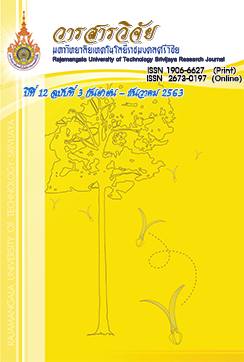Qualification Examination of Larvae Crab by Motion Detection Process
Keywords:
images processing, detection, motion detection, larvae crabAbstract
This paper describes motion detection algorithm and technique to examine the quality of mangrove crab larvae by detecting its movement quality using image processing method. OpenCV program was used to examine the quality of the larvae and mobile phone with 20x magnifying lens was used to record its movement during Zoea 1 (first three days after birth) with size range of approximate 40-50 microns (µm). The recording video files were processed with Object Detection, Object Filtering, and Object Tracking, respectively. 282 of mangrove crab larvae from five breeders were used in the study. Each breeder was cultured in separate truck. The larvae were randomly selected 10 times from each truck - 50 times in total. Their movement were then detected and tracked to examine the quality by calculating mean score of the movement. It was found that this method can be employed to detect and track moving objects well.
The result from examining the movement quality revealed that the larvae from the third truck showed the highest moving rate with 87.92%. It was likely that the truck contained the larva with the best developmental quality. It was then followed by the fourth truck with 40.44%, the first truck with 27.66%, the fifth truck with 23.82%, and the second truck with 19.51%, respectively.
References
Boon, T.K. and Haidi, I. 2012. A Literature Survey on Animal Detection Methods in Digital Images. International Journal of Future Computer and Communication 1(1): 24-25.
Chitradevi, B. and Srimanthi, P. 2014. An Overview on Image Processing Techniques. International Journal of Innovative Research in Computer and Communication Engineering 11(2): 6466-6472.
Forward, R.B. 2009. Larval biology of the crab rhithropanopeus harrisii (Gould): A synthesis. Biological Bulletin 216(3): 243-256.
Genodepa, J., Zeng, C. and Southgate, P.C. 2004. Preliminary assessment of a microbound diet as an Artemia replacement for mud crab, Scylla serrata, megalopa. Aquaculture 236(1):497-509.
Jain, S. and Chadokar, S. 2015. A Object Detection in Image Processing: A Review. International Journal of Electrical, Electronics and Computer Engineering 4(2): 26-29.
Jiang, Y., Li, Z., Fang, J., Yue, J. and Li, D. 2014. Automatic video tracking of Chinese mitten crabs based on the particle filter algorithm using a biologically constrained probe and resampling. Computers and Electronics in Agriculture 106: 111-119.
Koniar, D., Loncov, Z., Harga, L. and Be, P. 2015. Machine vision application in animal trajectory tracking. Computer Methods and Programs in Biomedicine 127: 258-272.
Pavlov, D.A. 2006. A method for the assessment of sperm quality in fish. Journal of Ichthyology 46(5): 391-398.
Piccardi, M. 2004. Background subtraction techniques: a review, pp. 3099-3104. In IEEE International Conference on Systems, Man and Cybernetics Background The Hague, Netherlands.
Ren, X., Wang, Z., Gao, B., Liu, P. and Li, J. 2017. Toxic responses of swimming crab (Portunus trituberculatus) larvae exposed to environmentally realistic concentrations of oxytetracycline. Chemosphere 173: 563-571.
Schwager, M., Anderson, D.M., Butler, Z. and Rus, D. 2007. Robust classification of animal tracking data. Computers and Electronics in Agriculture 56(1): 46-59.
Singla, N. 2014. Motion Detection Based on Frame Difference Method. International Journal of Information & Computation Technology 15(4): 1559-1565.
Sudtongkong, C., Wattanakul, W., Kong-oh, S., Danghnonghin, S. and Tunphiban, T. 2019. Survival and Growth of Juvenile Sesarmid Crab (Episesarma singaporense) Fed with Different Particle Size of Formulated Diets. Rajamangala University of Technology Srivijaya Research Journal 11(1): 169-180.
Tekalp, A.M. and Salman, F.S. 2007. Automatic Vehicle Counting from Video for Traffic Flow Analysis, pp. 392-397. In 2007 IEEE Intelligent Vehicles Symposium. Istanbul, Turkey.
Tillett, R.D., Onyango, C.M. and Marchant, J.A. 1997. Using model-based image processing to track animal movements. Computers and Electronics in Agriculture 17(2): 249-261.
Yilmaz, A., Javed, O. and Shah, M. 2006. Object tracking: A survey. ACM Computing Surveys 38(4): 1-45.
Zion, B. 2012. The use of computer vision technologies in aquaculture - A review. Computers and Electronics in Agriculture 88: 125-132.
Downloads
Published
How to Cite
Issue
Section
License
The content and information in the article published in Journal of Rajamangala University of Technology Srivijaya It is the opinion and responsibility of the author of the article. The editorial journals do not need to agree. Or share any responsibility.







